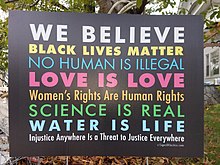This is an old revision of this page, as edited by Beyond My Ken (talk | contribs) at 18:01, 21 February 2021 (→top: This is an opinion essay, and therefore not a reliable source). The present address (URL) is a permanent link to this revision, which may differ significantly from the current revision.
Revision as of 18:01, 21 February 2021 by Beyond My Ken (talk | contribs) (→top: This is an opinion essay, and therefore not a reliable source)(diff) ← Previous revision | Latest revision (diff) | Newer revision → (diff)| It has been suggested that this article be merged into Black Lives Matter. (Discuss) Proposed since February 2021. |

In 2020 issue-based yard signs emerged in neighborhoods across the United States supporting multiple liberal movements commonly with a Black Lives Matter theme. Stemming from the original "Kindness is everything" sign with the introductory line “In this house, we believe:” many iterations begin more succinctly “We believe” after which a list of movements is enumerated often starting with Black Lives Matter. An even stack of colored lines of correlated phrases stand in vibrant contrast to one another against a black background.
According to Bonnie Kristian, partisan political signs for the 2020 election were largely passed over in favor of social justice signs. The Kindness is Everything sign originated as a white woman's show of opposition to Trump on his first day in office.
References
- Bologna, Caroline (8 March 2017). "'Kindness Is Everything' Signs Promote Love In Response To Hate". The Huffington Post.
- Cite error: The named reference
NewYardSignDiscoursewas invoked but never defined (see the help page). - Taylor, Chris (16 June 2020). "How one woman's yard sign became a rallying cry for allies". Mashable.